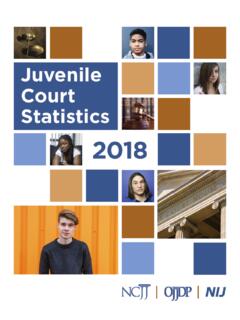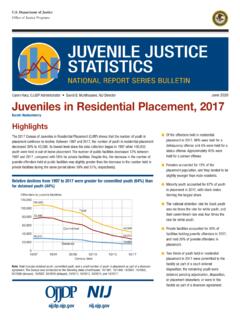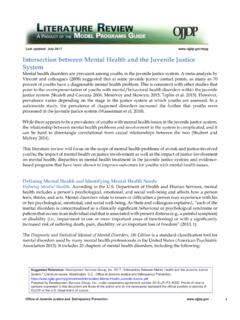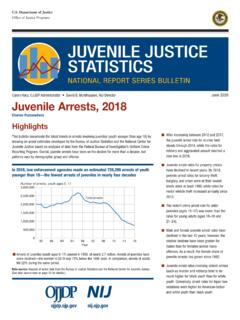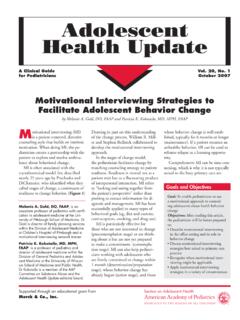Transcription of Transfer of Juveniles to Adult Court: Effects of a Broad ...
1 Of Juvenile Justice and Delinquency Department of JusticeOffice of Justice ProgramsOffice of Juvenile Justice and Delinquency Prevention December 2012 Melodee Hanes, Acting AdministratorPathways to Desistance How and why do many serious adolescent offenders stop of-fending while others continue to commit crimes? This series of bul-letins presents findings from the Pathways to Desistance study, a multidisciplinary investigation that attempts to answer this question. Investigators interviewed 1,354 young offenders from Philadelphia and Phoenix for 7 years after their convictions to learn what factors ( , individual maturation, life changes, and involvement with the criminal justice system) lead youth who have committed serious offenses to persist in or desist from offending.
2 As a result of these interviews and a review of official records, researchers have collected the most comprehensive dataset available about serious adolescent offenders and their lives in late adolescence and early adulthood. These data provide an unprece-dented look at how young people mature out of offending and what the justice system can do to pro-mote positive changes in the lives of these of Juveniles to Adult court : Effects of a Broad Policy in One CourtEdward P. Mulvey and Carol A. SchubertHighlightsThis bulletin presents findings from the Pathways to Desistance study about the Effects of Transfer from juvenile court to Adult court on a sample of serious adolescent offenders in Maricopa County, AZ.
3 The authors compare the extant literature with findings from the Pathways study and discuss the possible impli-cations of these findings for future changes in Transfer statutes. Following are some key points: Adolescents in the Adult system may be at risk for disruptions in their personal development, identity formation, relationships, learning, growth in skills and competencies, and positive movement into Adult status. Most of the youth in the study who were sent to Adult facilities re-turned to the community within a few years, varying widely in their levels of adjustment. Youth were more likely to successfully adjust when they were not influenced by antisocial peers.
4 Prior work indicates that transferred youth are more likely to commit criminal acts than adolescents kept in the juvenile justice system. Findings from the Pathways study indicate that Transfer may have a differential effect (either reducing or increasing offending), depend-ing on the juvenile s presenting offense and prior offense Juvenile Justice BulletinDECEMBER 2012 Transfer of Juveniles to Adult court : Effects of a Broad Policy in One CourtEdward P. Mulvey and Carol A. SchubertTransferring an adolescent offender to Adult court is a weighty decision. It has far-reaching implications for the adolescent involved and significant symbolic meaning for the justice system.
5 For the adolescent, Transfer to the Adult system holds the possibility of harsher punishment (in-cluding physical, sexual, or psychological victimization by other inmates) and enduring developmental costs (Chung, Little, and Steinberg, 2005; Mulvey and Schubert, 2012). For the system, transferring an adolescent to Adult court is an unambiguous statement that the criminal justice system will no longer shelter the adolescent, by virtue of his or her acts, from harsh justice. Transfer to Adult court indicates that the demand for proportional punishment has trumped the goal of individualized rehabilitation found in the juve-nile justice system (Zimring, 2005).
6 Since the court s inception, juvenile justice policymakers and professionals have wrestled with the decision about when to Transfer an adolescent to Adult court (Tanenhaus, 2004). Currently, individual states have combinations of statutorily defined mechanisms for determining when the movement of a juvenile case to Adult court is required or appropriate, including procedures such as judicial trans-fer, certification, automatic waiver, or direct file (Griffin, 2003; Fagan and Zimring, 2000). In general, state statutes define a set of crimes for adolescent offenders of a certain age that warrant processing in the Adult system ( , a statutory exclusion from the presumed jurisdiction of the juvenile court ).
7 Most states also have a mechanism ( , decertification, reverse waiver) for returning the case to the jurisdiction of the juvenile court when deemed appro-priate. (See Sickmund, 1994; Griffin, 2006; and Redding, 2008, for an elaboration of these statutory provisions.) Statutory standards have not always driven the process of transferring an adolescent to Adult court . For most of the history of the juvenile court , the decision to Transfer an ad-olescent offender to the Adult court rested primarily on the discretion of the juvenile court judge. Since the inception of the juvenile court in 1899, Transfer was possible for a range of heinous offenses when the juvenile court judge deemed that the resources available to the court were insuf-ficient to rehabilitate an adolescent (Tanenhaus, 2000).
8 During the late 1980s and early 1990s, however, a sharp rise in violent crime produced intense interest in the causes of juvenile crime and the effectiveness of the juvenile justice system. Juvenile arrests for violent offenses jumped dramatically during this time period, increasing 64 percent nationally between 1980 and 1994 (Butts and Travis, 2002). In addition, some highly publicized cases of Juveniles committing repeated, serious violent offenses contributed to public perception that the juvenile justice system was inadequate to intervene effectively with adoles-cents who were a legitimate threat to public safety (But-terfield, 1995).
9 These forces even prompted radical, and ultimately unfounded, rhetoric about a coming wave of adolescent superpredators unlike any previous juvenile offenders in their heartlessness and lack of response to interventions (DiIulio, 1995). In this context, the public began to distrust the ability of the juvenile justice system to ensure public safety, and state legislatures added statutory provisions to ensure that youth who committed certain serious offenses were not roaming the streets. Between 1992 and 1999, all but one state expanded legislation that made it easier for juve-niles to be tried as adults (Hansen, 2001). These changes increased the set of crimes that qualified an adolescent for Transfer , lifted age restrictions, and added statutory exclu-sion and prosecutorial discretion as methods for achieving Transfer to Adult court .
10 The movement of adolescents to Adult court was no longer the product of a juvenile court Juvenile Justice Bulletin 3 DECEMBER 2012judge exercising his or her discretion; it was instead largely the product of who fell into the statutorily defined net of eligibility and was not waived back to juvenile court . Rather than relying on a judgment of individual appropri-ateness regarding Transfer , the emphasis was instead on the act, not the actor, and on retribution, not rehabilitation (Griffin, 2006). Effects of Changes in Transfer Policies on PracticeIt is generally believed that these statutory reforms pro-duced an increase in the rate of Transfer , at least in a large number of locales (Fagan, 2008; Penney and Moretti, 2005).



